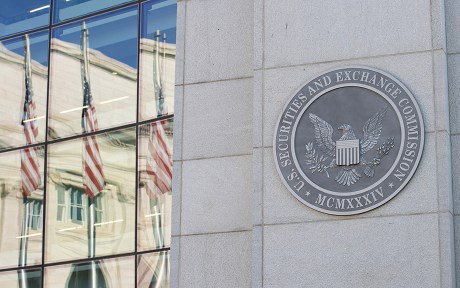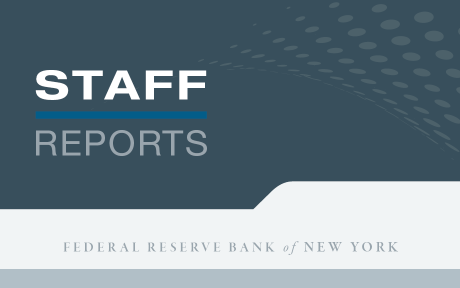
Recently instituted rule amendments have initiated a large migration of dealer-to-client Treasury repurchase trades to central clearing. To date, the main avenue used to access central clearing is Sponsored Service, a clearing product that has, until now, received little attention. This post highlights the results from a recent Staff Report which presents a deep dive into Sponsored Service. Here, we summarize the description of the institutional details of this service and its costs and benefits. We then document some basic facts on how market participants use this service, based on confidential data.
Why the Sudden Interest in Sponsored Service?
In December 2023, the Securities and Exchange Commission (SEC) instituted rule amendments to central clearing of Treasury repurchase (repo) trades that are expected to greatly expand the number of dealer-to-client trades that are centrally cleared. How firms will comply with these rule amendments is still uncertain, but it is likely that a substantial amount of repo will be centrally cleared using the Fixed Income Clearing Corporation’s (FICC) Sponsored Service offering.
FICC, currently the only central counterparty for Treasury repo, offers a full suite of clearing services for its direct clearing members. For a variety of reasons, not all repo market participants want (or are eligible) to become direct clearing members, and so repo trades with these firms are not eligible for FICC’s usual central clearing services (which are FICC DVP and GCF Repo; see this post for a map of U.S. repo segments).
FICC’s list of direct clearing members includes a wide variety of firms, but securities dealers account for a strong majority of centrally cleared trades. As such, for the purposes of this post, we characterize the direct clearing members as “dealers.”
Although dealer-to-dealer repos can be cleared and settled through the usual central clearing services, dealer-to-client trades cannot because the client is not a direct clearing member. Sponsored Service provide a way for these dealer-to-client trades to receive some of the benefits of central clearing. For these trades to be eligible for this service, clients must become sponsored members of FICC, a less stringent type of membership relative to direct clearing members, and dealers must become sponsoring members.
There are two forms of Sponsored Service. The first is “sponsored repo” and it uses the plumbing of FICC’s DVP Service. The second is “sponsored GC” and it uses the tri-party settlement platform offered by the Bank of New York Mellon. A main difference across the two offerings is that sponsored GC only accommodates general collateral transactions (the counterparties execute the trade agreeing that any securities within a specific class can be delivered) whereas for sponsored repo the counterparties agree upon the securities to be delivered at the time of trade execution.
The growth in sponsored GC mainly seems to be coming from repo transactions already cleared and settled on the tri-party settlement platform, a repo segment about which a lot is already known (see, for example, this post). As a result, this analysis focuses on sponsored repo.
What Are the Costs and Benefits of Sponsored Repo?
The main benefit to dealers from engaging with sponsored repo is balance-sheet netting. This accounting benefit allows for the net value of repo positions to be reported on a dealer’s balance sheet as opposed to the gross value. Netting can benefit a dealer because a smaller balance sheet typically requires holding less capital. For those dealers that are part of bank holding companies (BHCs), balance-sheet netting helps the BHC meet regulatory targets, such as the supplementary leverage ratio.
A necessary requirement to net two offsetting repos is for those trades to have the same counterparty. As a result, when a dealer enters into repos with a variety of clients, there can be no netting of trades across clients even if there are otherwise offsetting positions. If these dealer-to-client trades are successfully submitted to FICC, however, the result is that the dealer faces FICC across all these trades (this novation is a feature of central clearing), increasing the potential for balance-sheet netting.
A main cost to dealers from moving a trade into sponsored repo is likely to be higher margining costs, since all FICC trades are subject to a value at risk (VaR) charge in calculating margins. Furthermore, the dealer remains on the hook for the performance of the sponsored member (the client). These features often lead to the dealer having to post a larger amount of margin against the trade than would be the case if the dealer cleared the repo trade outside of central clearing.
How Is Sponsored Repo Being Used?
To analyze how market participants are using sponsored repo, we employ data collected by the Office of Financial Research (OFR) as part of its data collection on centrally cleared repo.
These data allow us to see a great amount of detail, including the specific securities exchanged, the cash principal amount, the repo rate, and the counterparties involved. Repos involving Treasury securities and agency debentures are observed in the data. However, to provide a cleaner analysis, we focus on Treasuries, which make up more than 99.9 percent of total activity.
We classify trades where the sponsored member is borrowing cash as “sponsored borrowing,” and trades where the sponsored member is lending cash as “sponsored lending.” All other trades are between two direct clearing members and, as such, are labelled “interdealer.”
In the table below, we display the average daily volumes by trade type over the sample period of January 2020 to June 2024. On average, sponsored trades made up 29.5 percent of total transaction volumes, with sponsored lending making up 15.9 percent ($244.3 billion) and sponsored borrowing making up 13.6 percent ($209.3 billion). Therefore, on an average day, sponsored repo is more heavily used to centrally clear dealer-to-customer trades where the customer is delivering cash and receiving securities.
Sponsored Repo Accounts for a Significant Share of Treasury Repo Activity
| Trade Type | Total (in Billions of U.S. Dollars) | Total (in Percent) |
|---|---|---|
| Sponsored lending | 244.3 | 15.9 |
| Sponsored borrowing | 209.3 | 13.6 |
| Interdealer | 1,086.1 | 70.5 |
| Total | 1,539.7 |
Note: The table shows average daily Treasury repo volumes in billions of dollars from January 2020 to June 2024, by trade type.
The two main groups of dealer customers that take advantage of sponsored repo are money market funds and hedge funds. Money market funds, which are looking to invest their cash holdings in short-term secured investments, dominate sponsored lending. Hedge funds dominate sponsored borrowing. The motivations for hedge funds vary across firms and time, however, a current driver of hedge fund borrowing behavior in sponsored repo is to implement a cash-futures basis trading strategy (see this article for more details).
The dynamics of sponsored repo are illustrated in the chart below, which plots total sponsored lending and borrowing over the sample period. From 2020, the beginning of the sample period, until 2022, sponsored lending activity was greater than sponsored borrowing, and often by a substantial amount. This pattern changed starting in mid-2022, when both types of sponsored repo became roughly equal in terms of value and both increased at a sharp clip, more than doubling in value by the end of the sample period.
Both Sponsored Borrowing and Lending More Than Doubled from 2022 to 2024
Billions of U.S. dollars
Note: This chart displays total daily sponsored Treasury repo activity by trade type.
Looking Ahead
Sponsored repo is likely to grow more important in the years ahead given the SEC’s central clearing mandate for Treasury repo. In addition to the rise in activity detailed above, many dealer clients are becoming sponsored members of FICC. Between December 2020 and August 2022, FICC’s list of sponsored members increased by only thirty-eight, whereas between August 2022 and July 2024, it increased by 555. In the next few years, understanding the details of sponsored repo and the trade-offs it presents relative to other forms of repo will only grow more important.

Adam Copeland is a financial research advisor in the Federal Reserve Bank of New York’s Research and Statistics Group.
R. Jay Kahn is a senior economist at the Federal Reserve Board.
How to cite this post:
Adam Copeland and R. Jay Kahn, “The Rise of Sponsored Service for Clearing Repo,” Federal Reserve Bank of New York Liberty Street Economics, October 8, 2025, https://doi.org/10.59576/lse.20251008
BibTeX: View |
Disclaimer
The views expressed in this post are those of the author(s) and do not necessarily reflect the position of the Federal Reserve Bank of New York or the Federal Reserve System. Any errors or omissions are the responsibility of the author(s).













 RSS Feed
RSS Feed Follow Liberty Street Economics
Follow Liberty Street Economics